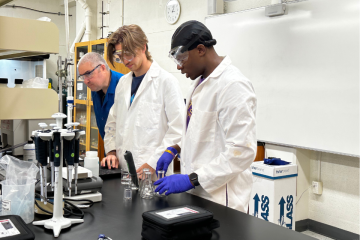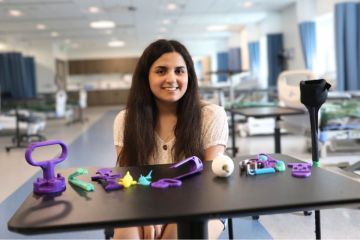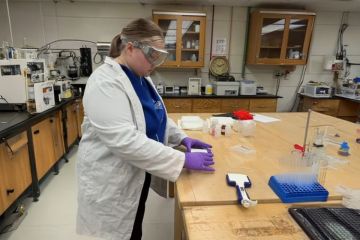Environmental Science/Biology Professor Named Sarnoski Fellow to Support Faculty-Student Research

Stephen R. Madigosky, chair of Widener University’s Department of Environmental Science and Sustainability, has been named the university’s fifth Cynthia H. Sarnoski Endowed Science Faculty Fellow to support his faculty-student research on how flightless animals move through the Amazon rainforest’s upper canopy.
Madigosky received the two-year fellowship to support his research focused on helping solve one of the greatest questions in animal behavior studies about whether directional control during a jump or fall is a precursor to flight.
Madigosky, a professor of environmental science and biology, has spent over three decades conducting research at the Amazon Conservatory of Tropical Studies (ACTS) near Iquitos, Peru.
I am grateful to Trustee Sarnoski for supporting not only my research, but also opportunities for students to conduct fieldwork in one of the most extraordinary, architecturally complex, and biodiverse environments on the planet. As junior research scientists, students will be involved in a project that has wide-ranging applications in evolutionary biology, and will have the opportunity to present this work to a national audience. — Professor Stephen Madigosky
The Sarnoski Fellowship supports science faculty through a generous gift made by Cynthia H. Sarnoski, who serves as vice chair of Widener’s Board of Trustees. Sarnoski graduated from Widener in 1974 with a bachelor's degree in chemistry. She is a retired senior vice president for Global Compliance and Quality Systems for Pfizer Pharmaceuticals.
“I have seen firsthand how Dr. Madigosky is committed to advancing his field and training the next generation of scientists,” Trustee Sarnoski said. “I am proud to continue this tradition of supporting faculty research and providing students with transformational opportunities.”
Alumna Gabrielle Hance ’19 benefited from these hands-on research experiences when she was a student at Widener. As a student, she traveled with Madigosky to Costa Rica to learn how shade-grown coffee encourages biodiversity and traveled to Peru with him to study how significant rainfall events affect the microclimate of the Amazon rainforest.
“Dr. Madigosky is extremely knowledgeable about these environments, and it was a truly amazing and informative experience to visit these locations with him and perform these research projects,” Hance said.
Exploring the Upper Canopy
Different flightless animals live high above the forest floor and move freely and rapidly through the complex architecture of the upper canopy space. Many show a remarkable degree of dexterity and can jump, glide, and grab even the slightest of hanging limbs or vines to quickly maneuver through the forest, according to Madigosky. Some animals have developed specialized structures for this purpose, such as gliding mammals (Colugos) and gliding snakes from southeast Asia. These animals have been able to forage within great distances and evade predators by jumping from tremendous heights and controlling their treetop descents. Yet little research has been conducted on similar adaptations in neotropical environments.
“Given these examples, a question that has perplexed scientists for decades is whether neotropical animals have evolved such mechanisms of descent,” Madigosky said. “This is perhaps one of the greatest questions that remain unanswered in animal behavior studies because directional control during a jump or fall is thought to be an important precursor stage in the evolution of flight.”
With this funding, Madigosky and his students will travel to the ACTS field station to study animal movement using high-speed video cameras. The facility has a walkway network of stations and bridges that extend from ground level to more than 100 feet above the forest floor, spanning more than a quarter mile through the treetops. This is an ideal location for carrying out this work.
“Currently, there are several species of animals that live among the treetops and transverse the canopy network very efficiently,” Madigosky said. “Having worked and conducted research at ACTS for over three decades, I have observed some very interesting aspects of animal behavior and will now conduct research to determine how animals living in this treetop environment efficiently navigate the precarious elements of the upper forest canopy.”
This will provide clues as to how they have adapted to overcome the dangers associated with this environment.
Hance said the faculty-student research in Peru was important to her understanding of the field. She now works as a field geologist at the geotechnical engineering company Earth Engineering, Inc.
“The various research projects that I participated in with Dr. Madigosky allowed me to apply the information that I learned in my environmental science classes to real world situations,” she said. “I had previously taken a tropical ecology class with Dr. Madigosky, and visiting Peru allowed me to further understand the topic and visualize what I had previously only read about in books.
Madigosky has taught at Widener since 1989 and has served as the chair of the Environmental Science Department since its inception in 1992. He served as the Director of Research at ACTS from 2001 to 2019 and has been an instructor at this location for the international rainforest workshop for teachers held each July for the past several decades.
“Dr. Madigosky has a distinguished record of teaching and research. This research will continue to advance his field of study and provide Widener students top-notch access to international field opportunities,” said College of Arts & Sciences Dean David Leaman.





